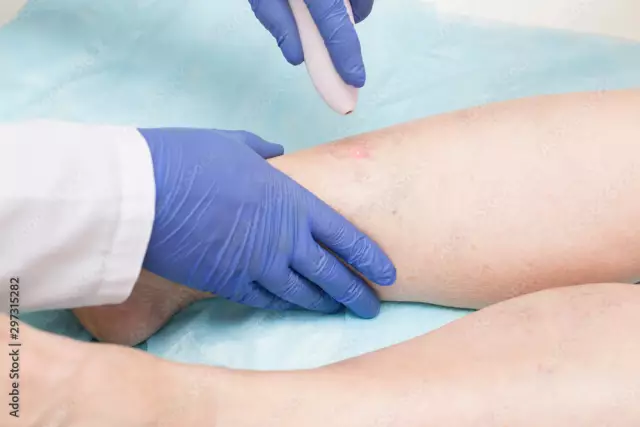- Author Rachel Wainwright [email protected].
- Public 2023-12-15 07:39.
- Last modified 2025-11-02 20:14.
Deep Vein Thrombosis: 8 Signs of Danger
Varicose veins are familiar to many: according to statistics, more than half of the entire adult population of the planet suffers from this disease. As a rule, varicose veins mainly affect the superficial vessels and are manifested by characteristic cosmetic defects. Deep vein thrombosis seems to be much more dangerous, since at the initial stages the disease can go unnoticed, and in advanced cases it threatens with a serious danger - thrombosis. This is a condition when a blood clot formed in a vessel breaks off and begins to move, reaching any organ. In such a situation, the risk of blockage of a large vessel increases, which leads to very sad consequences.
We will talk about not always noticeable, but extremely important signs of deep vein thrombosis in the article.

Source: depositphotos.com
Edema
With deep vein thrombosis, one of the lower extremities often swells. The fluid accumulated in the tissues due to impaired blood circulation does not find an outflow and is distributed along the entire length of the leg. The patient may experience discomfort when walking: to feel the bursting or tightness of the skin, heaviness, slight stiffness when bending the leg at the knee. Sometimes the edema is so mild that it becomes noticeable only when comparing the affected limb with a healthy one.

Source: depositphotos.com
Bulging veins
Outwardly, this symptom with deep vein thrombosis is less pronounced than with varicose veins. The occlusion of the vessel that has already occurred may be evidenced by the picture of the so-called spider veins - this is a dense venous network clearly visible under the skin, located not only on the lower leg, but also on the rest of the limb.

Source: depositphotos.com
Pain
A warning sign is severe, throbbing pain in the leg that comes on suddenly and gets worse when walking or standing for a long time. If such sensations arise regularly, the signal cannot be ignored: an urgent need to consult a doctor.

Source: depositphotos.com
Extremity fever
Deep vein thrombosis sometimes provokes a feeling of "burning" in the limb. This sensation is not at all similar to the discomfort in the feet that occurs, for example, when wearing the wrong shoes. "Burning" is manifested by strong heat on a small area of the leg, which is felt even 2-3 cm above the skin surface.

Source: depositphotos.com
Fatigue
Increased fatigue, lethargy and drowsiness are observed in a wide variety of diseases. In combination with other signs, these symptoms may indicate deep vein thrombosis.

Source: depositphotos.com
Dizziness
Patients suffering from thrombosis often complain of sudden dizziness, accompanied by an instant loss of balance and unpleasant visual effects (loss of image clarity, “flies” in front of the eyes). This is an alarming sign, often indicating that a blood clot is clogging up vital vessels.

Source: depositphotos.com
Coughing up blood
One of the most severe complications of deep vein thrombosis is pulmonary embolism (blockage of one of the vessels that supply blood to the lungs). A symptom of this condition may be a sudden, severe cough with blood streaks in the sputum. The situation requires urgent medical intervention.

Source: depositphotos.com
Dyspnea
Shortness of breath also indicates the possibility of developing pulmonary embolism, if it does not appear against the background of physical exertion or sudden movements, but in a calm state. Serious attention should be paid to this symptom, especially if the patient has neither chronic problems with the respiratory system nor excess weight.

Source: depositphotos.com
Until recently, deep vein thrombosis was considered a disease of older age. However, today the disease is often diagnosed in very young people. The risk factors provoking the development of the disease are bad habits (primarily smoking), a sedentary lifestyle, frequent and long air travel. The risk group includes people suffering from diabetes, obesity, and blood disorders. They should be especially attentive to their condition. If they have at least two of the symptoms described, they should see a doctor.
YouTube video related to the article:

Maria Kulkes Medical journalist About the author
Education: First Moscow State Medical University named after I. M. Sechenov, specialty "General Medicine".
Found a mistake in the text? Select it and press Ctrl + Enter.






